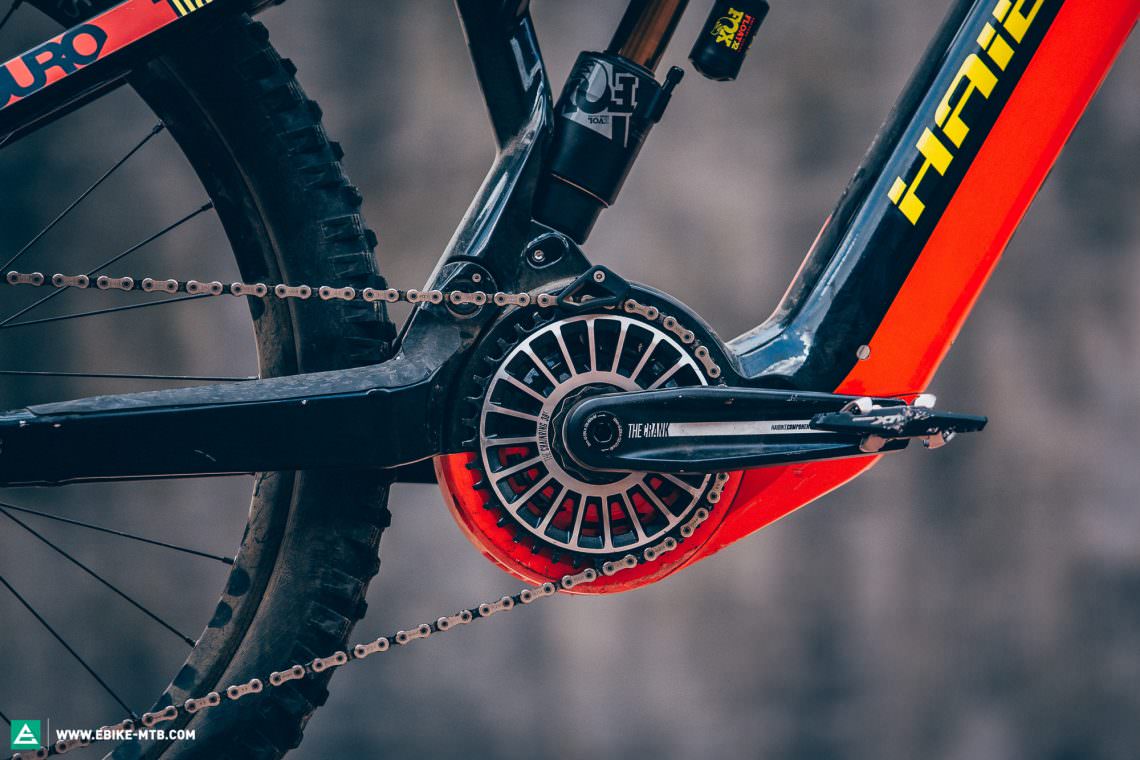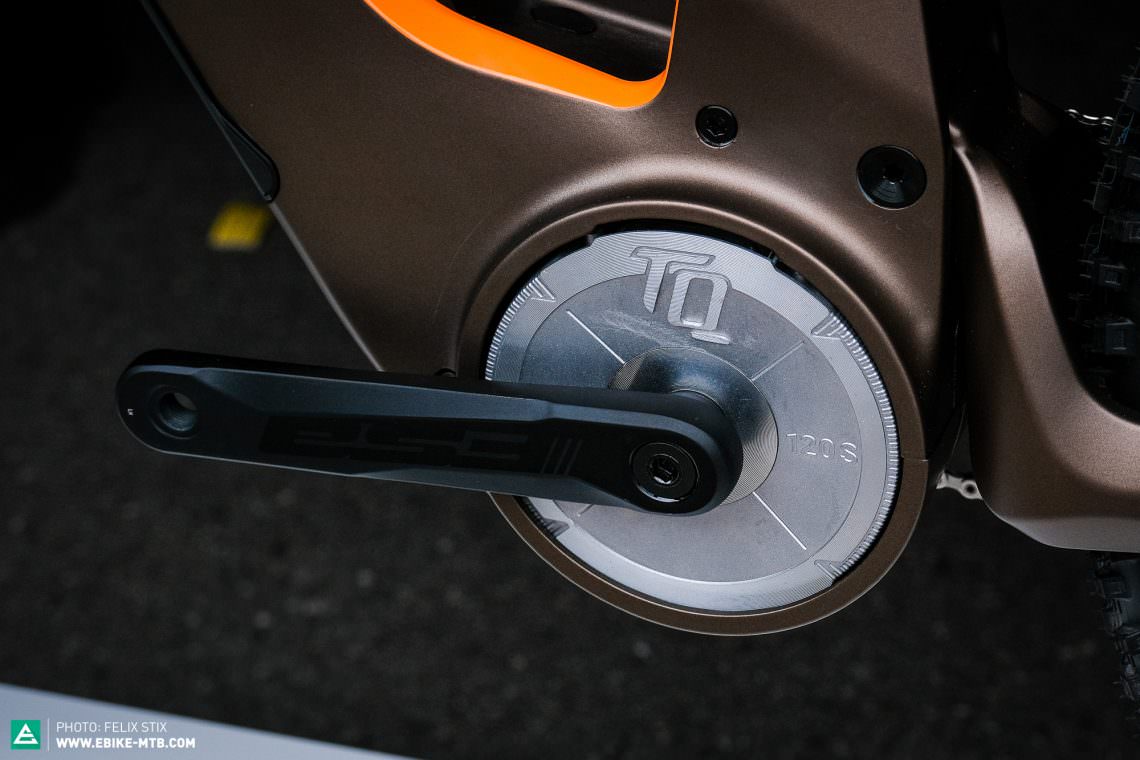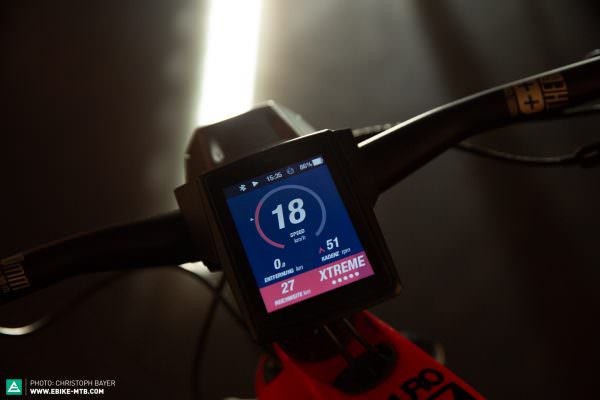The TQ HPR 120S was unknown amongst eMTBers for a long time, despite having been available since 2012! With the introduction of its FLYON series, Haibike resoundingly put TQ on the map. With some small modifications, it is the motor built into all models in the range.
This motor is part of our big e-mountain bike motor test. Click here for background information and the criteria of this test.

Power fans, pay attention! If you’re looking for the most powerful motor in the group test, then you’ve found it with the TQ HPR 120S. Producing 120 Nm torque it plays in its own league and puts out more power than all the other motors in the test. It surges ahead of the lightweight Specialized and FAZUA motors at the first stroke of the cranks. When things get steep and motors like the Bosch, Brose and Yamaha begin to falter, the TQ HPR 120S shoots playfully by, pretty much always sitting at the 25 km/h assistance limit, passing the powerful SACHS RS on the steepest of climbs. In the two higher assistance settings, the drive unit delivers a lot of power even at lower cadences. This is uphill flow at a completely new level! However, with all that power on tap, you’ll also need to pay attention when setting off to prevent the front wheel from lifting off the ground. If you’re inexperienced, you’ll need some time to get used to how to handle this motor.

The TQ HPR 120S doesn’t try to hide. While other motors are subtle and painted black, the silver TQ is polished to a high-gloss finish
Indeed, Haibike have taken some measures and fitted a high resolution speed sensor which helps prevent the rear wheel from spinning out or the front from lifting by modulating motor power. In the lower assistance mode, the motor still offers more than enough grunt for steeper ramps, but becomes easier to handle when setting off. That said, whatever mode you’re in, don’t expect a natural ride feel. While the motor feels smooth at the 25 km/h assistance limit, it’s pretty obvious when you accelerate from a standstill to the threshold within seconds and are then suddenly left without support. However, if you cruise at that threshold for a while, the HPS 120S regulates its output smoothly, meaning you’ll only really notice the change in support by the sound coming from the motor. The specially developed Pin-Ring gearbox can emit a loud buzz at full load, and depending on the design of the frame (and how much it amplifies noises) this can become unpleasant.

Haibike have put a lot of effort into developing the remote and massive central display. Other manufacturers often use the Marquardt remote with the TQ motor.

To control the motor’s monstrous power, Haibike use a high resolution speed sensor. This allows the motor firmware to modulate power to prevent losses in traction, similar to ESC or traction control on a car.
TQ leave manufacturers a lot of freedom when it comes to integration and tuning of the drive. Instead they are more interested in working collaboratively to develop complete and unified solutions. Haibike are the prime example of this approach. Together, the two companies have developed displays, remotes, batteries, speed sensors and of course a motor specifically tuned to match the FLYON concept. Just like Brose, with this degree of individualisation possible, there’s a lot of variation between different manufacturers using the same motor. Even with all this freedom, the HPR 120S poses some challenges in terms of integration. Its round form is relatively compact, but makes the positioning of suspension pivots difficult. At 3.9 kg it’s roughly 1 kg heavier than the all-rounders in our test. In addition, with so much power on tap, the tank has to be correspondingly big. In order to achieve satisfactory ranges, bike manufacturers are choosing batteries with 1000 Wh capacities and more. But even with a smaller battery, for example the 630 Wh option used by Haibike, bikes with this motor will never be lightweight. The 120 Nm torque not only puts a lot of load on the drivetrain, but also on the frame and other components, meaning that they have to be stronger and inevitably heavier.
Our conclusion
In terms of power, the TQ HPR 120S sets the benchmark! No other motor can hold a candle to it. But this kind of temperament needs to be controlled. At times, the drive can be unruly and requires an experienced rider or clever designer, who, similar to ESC and traction control in a car, will reign in the motor in extreme situations. In the end, the fun of the TQ is all in its immense power.
Tops
- most powerful ebike motor on the market
- no pedalling resistance
- compact dimensions
Flops
- loud at high cadences and at full load
- lots of power requires a large battery
- doesn't feel natural
For more information head to tq-group.com
Click here for background information and the criteria of this test.
Brose Drive S Mag | Bosch Performance Line CX | FAZUA Ride 50 Evation Firmware 2.0 | SACHS RS | Yamaha PW-X2 | Shimano STEPS E8000 | Shimano EP8 | TQ HPR 120S | Specialized SL 1.1
Did you enjoy this article? If so, we would be stoked if you decide to support us with a monthly contribution. By becoming a supporter of E-MOUNTAINBIKE, you will help secure a sustainable future for high-quality cycling journalism. Click here to learn more.
Words: Photos: E-MOUNTAINBIKE team









